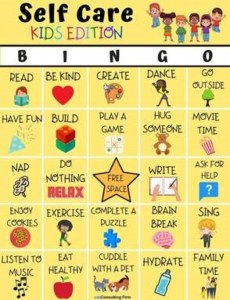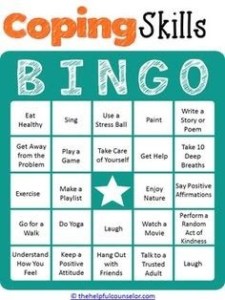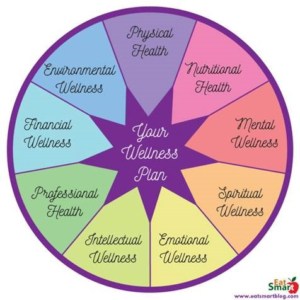Then play by naming the strategy for the client to mark off (or client can name for the therapist to mark off!)
- When a bingo is made, you can play a video of fireworks to celebrate!


- Copy of eduBINGO (wordpress.com)
- Sample Progress Note: The focus of the session was (tailor based on treatment plan). The therapist engaged the client in a coping skills activity (creating bingo card) to help them build their awareness of self-care activities. The Ct responded to the goal activity by (fill in the blank).
Couples strategy of the week:
- Connection Exercise: Taking a moment to pause and connect in the flurry of each day can generate a feeling of wellness within the relationship. This connection exercise consists of instructing the couple to breathe together, for a certain amount of time or number of breaths, to inspire greater attunement and intimacy.
- 7 Breath-Forehead Connection Exercise from PositivePsychology.com:
- Sit upright with your partner
- Gently put your foreheads together (tilt head so as to not rub noses)
- Take 7 deep breaths in sync (it may take a few breaths to get into a rhythm
- Should the couple wish, continue to 20-30 breaths and/or 30 seconds+
- Sample Progress Note: The focus of this session was… The therapist led the couple in a connection exercise (7 breath-forehead) to promote wellness and attunement within the relationship. The couple was (engaged/receptive/disengaged/etc.) during the exercise, and they (were able/struggled/somewhat able) to recognize the benefits of connecting to reduce stress.
Adult strategy of the week:
- Create a Wellness Plan: Overall wellness includes not only mental wellness, but physical, nutritional, spiritual, emotional, intellectual, professional, financial, and environmental wellness as well. This article explores the idea of overall wellness and provides guidance and prompts for developing a personal wellness plan.

- https://eatsmartproducts.com/fitness-and-wellness/why-you-need-a-wellness-plan-and-how-to-create-one/
- Sample Progress Note: The focus of this session was… The therapist provided psycho-education about mental health wellness and helped the client create a wellness plan including (emotional, mental, spiritual, etc.). The client reported that creating the plan was (helpful/not helpful/boring/etc.), and they (were able/struggled/hesitant/actively engaged, etc.) in developing a plan for their wellness.
Mindfulness/Meditation of the week:
- Three Steps To Wellness: As we start a new year it can be common to shift into gear quickly, so to say, and soon begin living in auto-pilot mode. Taking three steps towards mindfulness, through exercise below, can bring one back to a feeling of wellness.
- Sample Progress Note: The focus of this session was… The therapist led a mindfulness exercises (Three Steps to Wellness). Ct. (engaged/did not engage in the activity), and they reported that the mindfulness exercise was (helpful/difficult/not helpful)
Step 1: step out of “auto-pilot” to bring awareness to what you are doing, thinking, and sensing at this moment.
• Try to pause and take a comfortable but dignified posture. Notice the thoughts that come up and acknowledge your feelings, but let them pass. Attune yourself to who you are and your current state.
Step 2: bring awareness to the breathing for six breaths or a minute.
• The goal is to focus attention on one thing: your breath. Be aware of the movement of your body with each breath, of how your chest rises and falls, how your belly pushes in and out, and how your lungs expand and contract. Find the pattern of your breath and anchor yourself to the present with this awareness.
Step 3: expand awareness outward, first to the body then to the environment.
• Allow the awareness to expand out to your body. Notice the sensations you are experiencing, like tightness, aches, or perhaps a lightness in your face or shoulders. Keep in mind your body as a whole, as a complete vessel for your inner self;
• If you wish, you can then expand your awareness even further to the environment around you. Bring your attention to what is in front of you. Notice the colors, shapes, patterns, and textures of the objects you can see. Be present at this moment, in your awareness of your surroundings.
When you are ready to finish the exercise, open your eyes slowly and try to carry that mindfulness with you as you go about your day.


